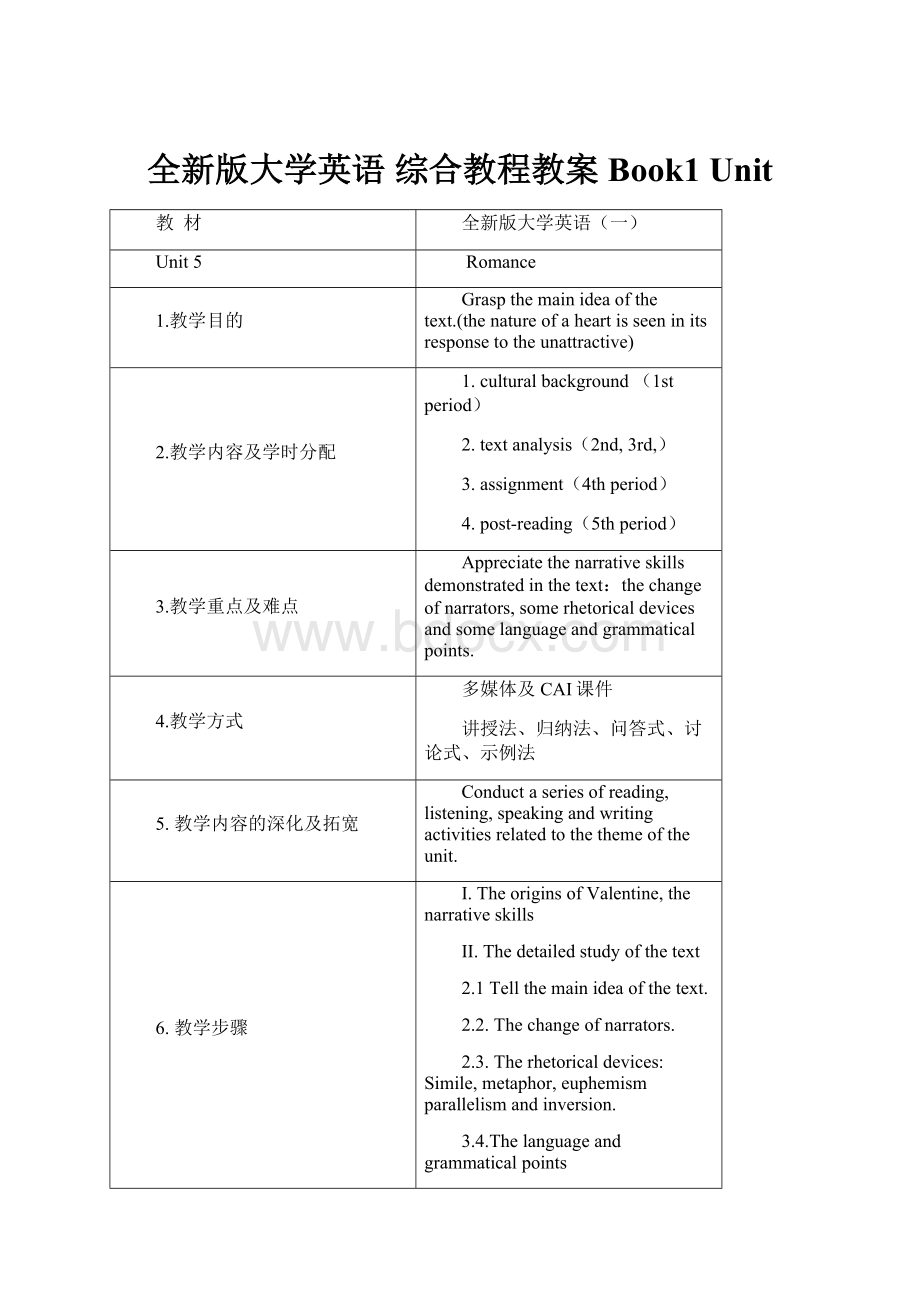全新版大学英语 综合教程教案 Book1 Unit.docx
《全新版大学英语 综合教程教案 Book1 Unit.docx》由会员分享,可在线阅读,更多相关《全新版大学英语 综合教程教案 Book1 Unit.docx(17页珍藏版)》请在冰豆网上搜索。

全新版大学英语综合教程教案Book1Unit
教材
全新版大学英语
(一)
Unit5
Romance
1.教学目的
Graspthemainideaofthetext.(thenatureofaheartisseeninitsresponsetotheunattractive)
2.教学内容及学时分配
1.culturalbackground(1stperiod)
2.textanalysis(2nd,3rd,)
3.assignment(4thperiod)
4.post-reading(5thperiod)
3.教学重点及难点
Appreciatethenarrativeskillsdemonstratedinthetext:
thechangeofnarrators,somerhetoricaldevicesandsomelanguageandgrammaticalpoints.
4.教学方式
多媒体及CAI课件
讲授法、归纳法、问答式、讨论式、示例法
5.教学内容的深化及拓宽
Conductaseriesofreading,listening,speakingandwritingactivitiesrelatedtothethemeoftheunit.
6.教学步骤
I.TheoriginsofValentine,thenarrativeskills
II.Thedetailedstudyofthetext
2.1Tellthemainideaofthetext.
2.2.Thechangeofnarrators.
2.3.Therhetoricaldevices:
Simile,metaphor,euphemismparallelismandinversion.
3.4.Thelanguageandgrammaticalpoints
III.Theculturalnotes
IV.Summary
V.Homework
Unit5Romance
TextAAValentineStory
I.TeachingPlan
1.教学目标及基本要求:
Objectives:
Studentswillbeableto:
1)graspthemainidea(thenatureofaheartisseeninitsresponsetotheunattractive)andstructureofthetext;
2)appreciatethenarrativeskillsdemonstratedinthetext(switchbetweentenses,changeofnarrators),somerhetoricaldevices(simileandmetaphor)andtheuseofinformallanguageinconversations;
3)masterthekeylanguagepointsandgrammaticalstructuresinthetext;
4)conductaseriesofreading,listening,speakingandwritingactivitiesrelatedtothethemeoftheunit.
2.教学内容及学时分配:
TimeAllocationandCourseArrangement:
1)Pre-readingtasks:
(1stperiod)
Textelicitationandbackgroundinformation
2)While-readingtasks:
(2nd,3rdperiod)
Textorganization,textanalysis,languagelearning,summaryaboutthewholetext
3)Post-readingtasks:
(4th,5thperiod)
Writingandhomework
SpeakingandDiscussion
3.教学重点及难点:
Difficultiesandkeypointsinteaching:
Appreciatethenarrativeskillsdemonstratedinthetext:
changeofnarrators,somerhetoricaldevicesandsomelanguageandgrammaticalpoints.
4.教学内容的深化及拓宽:
Abilityimprovement
Studentsconductaseriesofreading,listening,speakingandwritingpracticetodeepentheirunderstandingofthepointstaughtinclass.
5.教学方式及在教学中应注意的问题:
Teachingmethodsandproblemsshouldbepaidattentionto:
1)Acombinationoftraditionalteachingmethodswiththecommunicativeapproachwillbeadopted.
2)Specialattentionshouldbepaidtoclassroominteraction.
3)Moreencouragementandpraiseshouldbegiventostudentsfortheirvoluntaryanswersandopinions.
4)Moreencouragementisneededandmoreguidancewillbegiventothemintheirextracurricularstudy.
II.TeachingProcedures教学过程:
Pre-readingActivities:
1.Isromancedifferentfromlove?
Andifyes,how?
2.Didyoueverputatestonsomeoneyouliketodecideifheorshetrulylovesyou?
CulturalBackgroundInformation
(1).StValentine’sDay
ItfallsonFebruary14th,whenvalentinesareexchanged.Valentine’sDayisthefeastdayofSaintValentine.
SeveraldifferentstoriesaretoldabouttheoriginofSaintValentine’sDay.OnelegenddatesasfarbackasthedaysoftheRomanEmpire.Accordingtothestory,Claudius,theEmperorofRome,wantedtoincreasethesizeofhisarmy.Heknewthatitwouldbeeasiertogetyoungmenwhowerenotmarriedtojoin.Thereforehemadearulethatnoyoungmancouldmarryuntilhehadservedacertainnumberofyearsinthearmy.
ApriestnamedValentinebroketheruleandsecretlymarriedagreatmanyyoungpeople.Finally,ClaudiusfoundoutaboutValentineandputthepriestinprison,whereheremaineduntilhisdeathonFebruary14.
Afterhisdeath,Valentinewasmadeasaint,andthedayofhisdeathwasnamedSaintValentine’sDay.Itbecamethecustomforloverstosendeachothermessagesonthisday.NowSaintValentine’sDayisatimeforpeopletogiverosesorchocolatesandtosendgreetings.Nowinthewest,peoplechoosethisdayasengagement,weddings;universitiesandmiddleschoolsandsomeclubsholddancingpartyforlovers,storessellpresentsexpressingtenderlove,theatreshowslovethemeperformances,journalsonthehistoryofromance.
(2).LearnsomeProverbsaboutLove,RomanceandValentine
(Chineseproverb)Anoldmaninloveislikeaflowerinwinter.
(Welshproverb)Lovingawomanwhoscornsyouislikelickinghoneyfromathorn.
(Japaneseproverb)Amaninlovemistakesaharelip(兔唇)foradimple(酒窝).
(Englishproverb)Lovelivesincottagesaswellasincourt.
(Italianproverb)Thereisnolovelikethefirstlove.
(Swedishproverb)Alifewithoutloveislikeayearwithoutsummer.
(African-Americanproverb)Tellmewhomyoulove,andI'lltellyouwhoyouare.
(FrenchProverb)Trytoreasonaboutloveandyouwillloseyourreason.”
(LatinProverb)Loveandacoughcannotbehid.
(Proverb17thcentury)Lovemakestheworldgoround.
(Proverb14thcentury)Loveisblind.
(GreekProverb)Theheartthatlovesisalwaysyoung.
(FrenchProverb)Lovemakesthetimepass.Timemakeslovepass.
While-readingActivities:
1.Thistextisanarration.Fromthedescriptioninthefirstparagraph,whatdoyouthinkMr.Blanchardwasdoing?
(Hewasexpectingsomeone.)
2.Inthesecondparagraph,theauthornarratedthat“Helookedforthegirlwhoseheartheknew,butwhosefacehedidn’t,thegirlwiththerose”.HowcomeMr.Blanchardknewherheartwithoutevenknowingherface?
(Theykeptcorrespondingforayearbutneverseeneachother.)
3.WhatkeptMr.BlanchardfromseeingMissMaynell?
(HewasshippedoverseasforserviceinWorldWarII.)
4.Paragraph4tellsusthereasonwhyMissMaynellrefusedtogiveMr.Blanchardaphotograph.Whatisit?
(Shethoughtwhatshelookeddidnotmattertotheirfeelingsforeachother.)
5.Fromthelettershewrotetohim,HowwouldMr.BlanchardrecognizeMissMaynellattheirfirstmeeting?
(Shewouldbewearingaredroseonherlapel.)
6.Inparagraph7,theauthorchangedthenarratorandletMr.Blanchardtellhisownstory.Why?
(Hewantedtomakethestorymorerealandvividbylettingtheherotellhisownstory.)
7.Compareparagraph7and10,12andsaywhatyourfeelingisafterreadingthetwoparagraphs.
8.WhatwasMr.Blanchard’sfeelingwhenhesaw“MissMaynell”?
(Hefeltverydisappointed.)
9.Whydidn’tMr.Blanchardturnawayfrom“MissMaynell”?
10.Didtheelderladyknowwhatwasgoingon?
(No,butshetoldMr.BlanchardwhyshewaswearingtheredroseandaskedhimtomeetMissMaynell.)
11.HowcometheelderladyworetheroseinsteadoftherealMissMaynell?
(ItwasatestMissMaynellputtoMr.Blanchard.)
12.Paraphrasethesecondsentenceofparagraph16andseethepurposeofthetestMissMaynellputtoMr.Blanchard.
13.Whatdoesthelastparagraphmeanandhowisitrelatedtothestory?
2.TextAnalysis(20minutes)
A.RhetoricDevices.
Inthistext,therearesomerhetoricdevices.
Simile:
afigureofspeech,using“like”or“as”,inwhichonethingiscomparedtoanother,whichonlyresemblesinoneorasmallnumberoftheways.
e.g.Hereyeswereblueasflowers.(Para7L35-36)
Andinherpalegreensuitshewaslikespringtimecomealive.(Para7L36-37)
Metaphor-afigureofspeech,inwhichaqualityorcharacteristicisgiventoapersonorthingbyusinganame,image,adjective,etc.Itisnormallyusedsomethingelsewhichhasgreatlysimilarqualities.
e.g.Eachletterwasaseedfallingonafertileheart.(Para4L15)
Paraphrase:
Eachletterfromonewouldbringforthawarmresponsefromtheother,justasaseedfallingonfertilesoilislikelytogrowintoaplant.
WhileIspokeIfeltchokedbythebitternessofmydisappointment(Para14L58-59
Metaphoriscomposedof2parts,tenor(本体)andvehicle(喻体).Tenoristhethingwearetalkingabout;vehicleisthattowhichwearecomparingit.
Twokindsofmetaphors:
i.Judgingmetaphor
ii.Qualifiedmetaphor.
InA,thetenorandvehiclearelinkedbytheverbtobe.
e.g.Lifeisashortsummer.(Johnson)
Alltheworldisastage.(Shakespeare)
InB,therelationshipbetweentenorandvehicleistoqualifyandbequalified,andislinkedbyof.
Ifmusicisthefoodoflove,playon.(Shakespeare)
Thesimilaritybetweentenorandvehiclemaybebasedonlikenessinform/appearance.
e.g.theeyeofaneedle,theteethofacomb,theneckofabottle.
Onaresemblanceinrelativeposition.
e.g.thefootofapage,thesideofahill
Sometimestheresemblancemaybeinquality/infunction.
e.g.bookworm---apersondevotedtoreadinginthepipeline.
C.NarrativeSkills
1.SwitchbetweentensesPara6frompasttensetofuturetense,Para14,Para16presenttense…
2.changeofnarrator:
3rdpersonnarrator(Para2,3,,4),1stpersonnarrator(Para8,9,13,14),omniscientnarrator(Para3,4,5,11,16).
TextOrganization
Parts
Paragraphs
MainIdeas
PartOne
Para.1
JohnBlanchardwasexpectingsomeoneatGrandCentralStation
PartTwo
Paras2-6
HowJohnBlanchardhadfalleninlovewithMissMaynell.
PartThree
Paras7-15
MissMaynellputBlanchardtoatest.
PartFour
Paras16-17
ItwaswiseofMissMaynelltogivesuchatest.
LanguagePoints:
WordsandExpression
(1)straighten:
v.(causeto)becomestraightorlevel
e.g.:
Theroad~edafteraseriesofbends.
Womenusedtouseahotironto~theirhair.
Theprofessorwould~histiebeforeenteringtheclassroom.
→~sth.out:
settleorresolvesth.;removedifficultiesfromsth.
e.g.:
Let’strytostraightenoutthisconfusion.
→~sb.out:
(infml.)removethedoubtorignoranceinsb.’smind
e.g.:
You’reclearlyrathermuddledaboutofficeprocedurebutI’llsoonstraightenyouout.
(2)ma